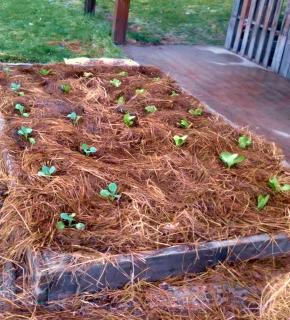

Among all types of manure, horse manure certainly has the most balanced mix of nutrients. It’s perfect for spreading in both the vegetable patch and the garden, in flower beds and along borders.
→ For further information:
Like all other types of manure, horse manure (and also pony or donkey!) consists of dry matter (straw), urine and feces (dung). It’s a hot manure that quickly heats up as it breaks down. It contains more woody matter (hence cellulose) than others (about 54%).
 It’s a manure well balanced in carbon, potassium, and nitrogen, fairly neutral in terms of acidity. However, it’s poorer in phosphorus than other manures. Calcium and magnesium contents are also very interesting. This ideal composition makes horse manure a very good soil amendment and a quality organic fertilizer.
It’s a manure well balanced in carbon, potassium, and nitrogen, fairly neutral in terms of acidity. However, it’s poorer in phosphorus than other manures. Calcium and magnesium contents are also very interesting. This ideal composition makes horse manure a very good soil amendment and a quality organic fertilizer.
Horse manure can be found in different forms:
 Because of its high woody matter content, horse manure is recommended to improve heavy and clay soil, lighten and aerate it. This addition will help promote water and air penetration.
Because of its high woody matter content, horse manure is recommended to improve heavy and clay soil, lighten and aerate it. This addition will help promote water and air penetration.Fresh manure is spread only in the fall. Thus, it will have time, during winter, to decompose. Earthworms and other soil microorganisms, assisted by the weather, will take care of decomposing it and integrating it into the soil. As spring returns, soil will be richer and naturally amended.
How do you spread your horse manure in autumn?
 Spread the dried manure on the bare ground (or atop a layer of cartons if you have grass underneath) in the garden in a thick layer at a rate of 6 pounds per square yard (3 kg per square meter) the first year. Every two-3 years after that, it’s enough to just add 2 pounds per square yard (1 kg per square meter).
Spread the dried manure on the bare ground (or atop a layer of cartons if you have grass underneath) in the garden in a thick layer at a rate of 6 pounds per square yard (3 kg per square meter) the first year. Every two-3 years after that, it’s enough to just add 2 pounds per square yard (1 kg per square meter).It is also possible to simply spread a layer of manure, without adding anything on top.
→ But don’t forget that fresh horse manure can burn plants. It’s got too much nitrogen and ammonia. So, never lay it fresh at the foot of your plants.
Decomposed or composted manure is spread in spring, just before planting or sowing vegetable plants:
In spring, you can also add some at the base of your trees, shrubs, and perennial garden plants.
→ It is useless, even discouraged, to integrate manure into your garden or vegetable garden soil every year. This contribution can be made every two to three years.
 In the vegetable garden, many plants are especially fond of horse manure. Especially nutrient-hungry vegetables such as tomato, squash, pumpkin and zucchini, eggplant, bell pepper and chili, melon…
In the vegetable garden, many plants are especially fond of horse manure. Especially nutrient-hungry vegetables such as tomato, squash, pumpkin and zucchini, eggplant, bell pepper and chili, melon…
Potato will also appreciate this manure for the significant supply of potash. Finally, don’t hesitate to provide it to lettuce and all vegetables that like rich soils. Fruit trees and roses will also love being supplied with horse manure.
→ Only alliums like onion, garlic and shallot are better off without it.
After six weeks, you can use this decomposed horse manure.
→ To learn more: Everything to know about manure and its usefulness
Don’t hesitate to walk into riding clubs and stud farms to ask for a few buckets of horse manure. They are generally quite happy to get rid of it!